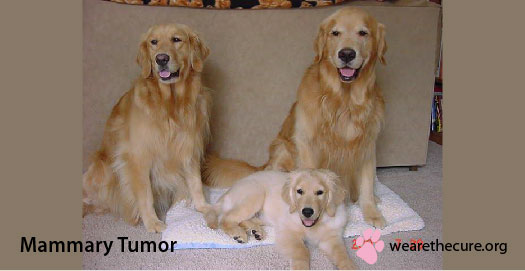Mammary Tumors
 Description – Canine mammary tumors or mammary neoplasms are among the most common type of lesions found in female dogs. They arise from different types of tissues (epithelial or glandular tissues, and mesenchymal or connective tissues) in the mammary gland. Intact dogs are seven times more likely to contract the disease than ones which have undergone spaying or ovarihysterectomy (surgical removal of ovaries and uterus) before their first or second heat period. Several spaniel breeds, poodle, toy dachshund and terriers are more prone to the disease. However, a recent study has revealed that smaller breeds have a relatively low incidence compared to their bigger counterparts.
Description – Canine mammary tumors or mammary neoplasms are among the most common type of lesions found in female dogs. They arise from different types of tissues (epithelial or glandular tissues, and mesenchymal or connective tissues) in the mammary gland. Intact dogs are seven times more likely to contract the disease than ones which have undergone spaying or ovarihysterectomy (surgical removal of ovaries and uterus) before their first or second heat period. Several spaniel breeds, poodle, toy dachshund and terriers are more prone to the disease. However, a recent study has revealed that smaller breeds have a relatively low incidence compared to their bigger counterparts.
Causes- The development of these tumors is hormone-induced. The female reproductive hormone progesterone has been linked to the disease. Spaying females before 2 to 2 1/2 considerably reduces the risk of both benign and malignant tumors. But if they are spayed after this period chances of benign tumors are reduced but possibility of malignant tumors remains alive. Hormones do not have any direct mutagenic effect on mammary cells. It is believed that cell growth induced by these hormones leads to malignant transformation. In dogs which have been spayed early the source of the hormones is eliminated, which puts these dividing cells at risk of mutation and malignant transformation by environmental carcinogens. Therefore, administration of drugs that have a combined progestagenic-estrogenic activity increases the risk of malignant tumors. Growth hormone production induced by progestines, leads to a rise in the blood levels of insulin like growth factor that might lead to malignant tumors. Other factors include proteins like E-cadherin, connexins and paxillin.
Symptoms – Mammary tumors can be small, simple nodules or large, aggressive, metastatic growths. The tumors can occur in one or more glands. The clinical signs include pain, ulceration, and inflammation in the overlying skin, fixation to the skin or underlying tissues, firmness, thickening, edema (abnormal accumulation of fluid), erythema (redness). In case of advanced metastasis the disease spreads to lymph nodes, lungs, colon, kidneys, liver and sometimes bone.
Treatment – The diagnostic techniques comprise thorough physical examination, routine hematologic and serum chemistry profile, urine analysis, chest X-ray coagulogram, thoracic radiographs, caudal abdominal radiograph and a rectal examination. Fine needle aspiration with cytology (FNAC) is also conducted to differentiate between benign and malignant tumors. It is very important to find out which stage the disease is in before initiating any treatment. Surgery is the most commonly used treatment here. There are various types of them depending upon the size of the tumors, fixation to the surrounding tissue and the number of lesions. These are lumpectomy, mammectomy, radical mastectomy, unilateral or bilateral mastectomy.
Lumpectomy or nodulectomy as it is called involves removal of benign superficial, non-fixed nodules. It is a non-invasive method and is recommended if the tumor is localized. It is the most convenient method of breast conservation.
Mammectomy is indicated for patients with centrally developed lesions in one gland. If they are too firm and fixed to the skin, the abdominal fascia is also removed along with the gland.
Radical mastectomy A regional mastectomy in dogs means all the breasts, the skin
covering them, and the four lymph nodes are all removed at the same time.
Bilateral mastectomy involves removal of both the breasts as a whole mass
 Chemotherapy, radiation therapy and hormonal therapy have been used to treat inoperable patients but not with much success. Many veterinarians spay a dog undergoing a mastectomy. She will benefit by having the ovaries and uterus removed for it can minimize chances of camouflaging her tumors with a false pregnancy and eliminates the chances of ovarian and uterine tumors. Moreover, spaying will allow easy detection of any new tumors that may arise because post surgery, the mammary tissue shrinks.
Chemotherapy, radiation therapy and hormonal therapy have been used to treat inoperable patients but not with much success. Many veterinarians spay a dog undergoing a mastectomy. She will benefit by having the ovaries and uterus removed for it can minimize chances of camouflaging her tumors with a false pregnancy and eliminates the chances of ovarian and uterine tumors. Moreover, spaying will allow easy detection of any new tumors that may arise because post surgery, the mammary tissue shrinks.
Some times radiation therapy is used intraoperatively and also post operatively to reduce the chances of recurrence.
According to the standard chemotherapy dosage Adriamycin is recommended every 21 days and oral Cytoxan every other day for 8 weeks or on day 3-6 of each 21 day cycle. More recently, many vets are resorting to mitoxantron (Novantrone™) as a first choice and then Adriamycin or Carboplatin for resistant disease. It may prevent the circulating cells from metastasizing to the lungs.
Prognosis – The chances of survival in case of mammary tumors depends on the size of the lesions. If they are less than 3 cm in size the prognosis is quite heartwarming. But for tumors more than 1.5 inches in diameter the chances of survival are bleak. In the instances where it has metastasized to the lymph nodes prognosis is very poor.
Thank you for utilizing our Canine Cancer Library. Please help us keep this ever evolving resource as current and informative as possible with a donation.
Reference
Withrow and MacEwen’s Small Animal Clinical Oncology – Stephen J. Withrow, DVM, DACVIM (Oncology), Director, Animal Cancer Center Stuart Chair In Oncology, University Distinguished Professor, Colorado State University Fort Collins, Colorado; David M. Vail, DVM, DACVIM (Oncology), Professor of Oncology, Director of Clinical Research, School of Veterinary Medicine University of Wisconsin-Madison Madison, Wisconsin
Other Articles of Interest:
Blog: How To Help Pay For Your Dog Cancer Treatment Cost: 7 Fundraising Ideas
Blog: What Are Good Tumor Margins in Dogs and Why Are They Important?
Blog: Dispelling the Myths and Misconceptions About Canine Cancer Treatment
Blog: Financial Support for Your Dog’s Fight to Beat Cancer
Blog: Cancer Does Not Necessarily Mean A Death Sentence
Blog: What To Do When Your Dog Is Facing A Cancer Diagnosis – Information Overload
Blog: Dog Cancer Warning Signs: Help! I Found a Lump on My Dog


Recent Comments